 A large selection of modern materials for knitting attracts more and more people who want to join the ranks of knitters, because any girl (woman) wants to emphasize her individuality with an original wardrobe.
A large selection of modern materials for knitting attracts more and more people who want to join the ranks of knitters, because any girl (woman) wants to emphasize her individuality with an original wardrobe.
Having once knitted a scarf, you need to master knitting the next, more complex product, such as a sweater.
Learning to knit on your own is quite difficult, but it is doable with a certain amount of perseverance, diligence and accuracy.
This article can be a great help in mastering the intricacies of this fascinating hobby.
Yarn selection
 The first thing to do is choose yarn for knitting, because it depends on how the item will look and fit on the figure of its owner.
The first thing to do is choose yarn for knitting, because it depends on how the item will look and fit on the figure of its owner.
There are a huge number of types of yarn: from the finest weaves to thick yarn made from natural wool for knitting bulky items and home furnishings.
From all the variety, we can highlight the main types of yarn, which are best for beginners to take a closer look at.
Wool
 This type of yarn is considered lighter and more flexible than, for example, vegetable yarn. She retains heat well, is not hygroscopic like cotton, but is inferior to it in strength.
This type of yarn is considered lighter and more flexible than, for example, vegetable yarn. She retains heat well, is not hygroscopic like cotton, but is inferior to it in strength.
Unfortunately, wool quickly loses its “marketable” appearance, matting and becoming overgrown with “pellets”. To prevent this from happening too quickly, manufacturers add artificial threads, such as acrylic, to wool threads, and also twist the threads more tightly.
Wool products require more delicate care, such as hand washing with mild detergents and drying flat to avoid loss of shape.
"Angora"
This is the fluff of goats or Angora rabbits - airy and soft yarn. This breed of animal is distinguished by its silky and long coat, with a soft natural shine. The finished products are airy and pleasant to the body, great for children's clothing.
 Angora dyes well, allowing you to achieve a wide range of colors from light to acid-bright. As with any natural wool, synthetic fibers are woven into angora in various proportions.
Angora dyes well, allowing you to achieve a wide range of colors from light to acid-bright. As with any natural wool, synthetic fibers are woven into angora in various proportions.
Important! Washing products made from angora requires a careful approach so as not to destroy the base of the fluff.
Mohair
It is generally accepted that any soft and fluffy yarn is mohair, but this is not true. Mohair threads may contain synthetic fibers. And pure and natural mohair can be seen in the products of Orenburg craftswomen, and specifically in scarves.
 This type of yarn is one of the most expensiveTherefore, to reduce the cost of the finished product and increase strength and durability, mohair is spun together with artificial threads or natural wool.
This type of yarn is one of the most expensiveTherefore, to reduce the cost of the finished product and increase strength and durability, mohair is spun together with artificial threads or natural wool.
Boucle yarn
This the term is taken from French, where "boucle" means "curly", because the yarn itself resembles curly strands of astrakhan wool.

An eye-catching sweater without a pattern
It is easy to knit even for beginner needlewomen.
 As you know, the more textured and interesting the yarn, the simpler the pattern should be.
As you know, the more textured and interesting the yarn, the simpler the pattern should be.
Yarn with lurex
A sweater using this yarn will decorate the wardrobe of any fashionista! NLurex threads are most often an addition to the main thread, adding a festive shine to the finished product.
 Experienced knitters also use Lurex for decorative finishing or knitting prints on products.
Experienced knitters also use Lurex for decorative finishing or knitting prints on products.
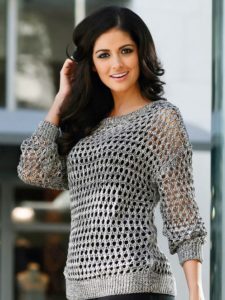 It should be noted that Lurex is a synthetic yarn, and is not very pleasant to the body due to its “prickliness”. This shortcoming pays off with a huge palette of colorful yarn!
It should be noted that Lurex is a synthetic yarn, and is not very pleasant to the body due to its “prickliness”. This shortcoming pays off with a huge palette of colorful yarn!
Advice! From the same manufacturer, the shades of yarn may vary depending on the batch, so if you don’t want to end up with a spotted item, buy yarn with a reserve. And by preserving the receipts and the presentation of the skeins, you can return the excess.
Tools
 Craft supply stores most often offer hooks and knitting needles made of the following materials: metal, wood, plastic.
Craft supply stores most often offer hooks and knitting needles made of the following materials: metal, wood, plastic.
You can knit with any knitting needles, but for beginners they recommend plastic or wood, The outer loops slip off from such knitting needles less often, because at the initial stage of training this is a very serious problem; you don’t have enough skills to lift them and you have to re-tie everything.
Having bought a pair of working knitting needles, buy them with circular knitting needles on fishing line of the same number, they will be useful for knitting the neckline. To select the correct knitting needle diameter, study the label on the yarn; the numbers of suitable knitting needles are indicated there.The knitting density is also prescribed, but this is an individual criterion and should not be relied on.
Important! When purchasing circular knitting needles, pay attention to the junction of the knitting needle and fishing line; the more even and smooth it is, the better. The diameter of the fishing line itself should not differ greatly from the diameter of the knitting needles, as this will subsequently complicate the movement of the loops and create discomfort when knitting.
Loop calculation
The key step in knitting a sweater is the correct calculation of the loops, because it depends on him whether the item will fit in size or whether it will need to be bandaged from start to finish. Therefore, you should be extremely careful.
 We cast on 25-35 stitches and knit with the pattern we chose, about 15 centimeters. Close the loops and cut the thread.
We cast on 25-35 stitches and knit with the pattern we chose, about 15 centimeters. Close the loops and cut the thread.

Knitting sample 10-15 cm
The resulting sample should be washed and steamed so that the yarn takes its final shape.. And then calculations are made of the loops and the number of rows per 1 cm of the resulting fabric, and the results are recorded in a notebook.
Important! When calculating loops and rows, you need to stretch the knitted fabric a little, imagining how much it will stretch when worn (depending on the product).
Pattern selection
For beginner knitters, it is better to focus on the yarn, choosing voluminous, textured or lurex.
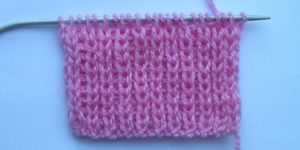
Garter stitch
But for the pattern classic garter stitch is suitable, which is knitted with the front stitches alone, behind the front wall.

Knitting braids
Having mastered the technique of knitting such a loop, you can begin knitting a sweater (as in the photo). Knitting needles No. 7 and bulky yarn.
Knitting according to the pattern
Back
The product begins to be knitted from the back, thanks to which you can correct minor shortcomings (small number of cast-on loops) at the expense of the front.
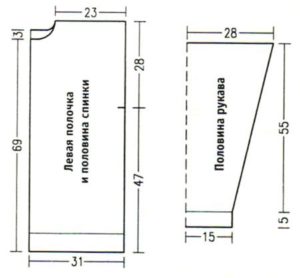
Easy sweater pattern
You can knit without a pattern, take a T-shirt or an old sweater.

Sweater pattern

White women's sweater
Just in case, it is better to take measurements of the back and half-circumference of the chest; the front shelf should be larger.

Sweater “Bat” style

Sweater with dolman sleeves
It is better to knit a sweater loosely.

Women's sweater pattern
Advice! If you are the owner of a gorgeous 3+ bust, then the front of the sweater, in any case, needs to be made a little wider.

Pattern of a women's sweater with a neck
Putting 2 knitting needles together, cast on the required number of stitches +2 edge stitches.

English rib knitting
First, 5-10 rows are knitted with English elastic, alternating purl and knit stitches; there are two types: 1*1 or 2*2. It is better to choose the first option, it is denser and more elastic.
At the end of the row, turn the product over and knit “according to the pattern.” For the elastic you need to knit about 10 cm.
Next, the pattern is knitted, only with facial loops on both sides.
The fabric is knitted to the shoulder line. This model does not provide for knitting the armholes; the sleeves are slightly lowered. This will not confuse the novice needlewoman and will give her confidence in her skills!

Knitting back to neck
When it's time to knit the neckline, you need to do the following. From the beginning of the row we knit 20 loops according to the pattern, also count 20 loops from the other edge, and the middle must be closed, that is, knitted together, returning the loop back to the knitting needle. Each side is knitted separately.
Turn the work over, knit a total of 12 loops - the last 3 are “removed” by knitting 2 loops together according to the pattern.
You should decrease 3 loops from the side of the neckline, knitting 2 rows on each side.
Front of a woman's sweater
The front is knitted in the same way as the back, but the neckline should be made deeper, with a smooth decrease. To do this, you need to decrease the loops 3-5 rows earlier, depending on the thickness of the yarn.
Sleeves
Knitting sleeves begins in the same way, with elastic. Since the sleeve will be lowered, you won’t have to worry about knitting the armhole. The only thing is that you need to learn how to add loops, because the sleeve should expand smoothly, it is better to do this every four rows.

Yellow openwork sweater
The number of added loops depends on the thickness of the selected yarn. Having knitted the required sleeve length, the loops are closed in the classic way. Knit two parts.
Assembly of finished parts
Before sewing and assembling the sweater, the parts are washed in cold water and dried horizontally, on a large towel.

Long beige sweater
The assembly starts from the shoulder seams. Then the sleeves are sewn in, and lastly the side seams. All connection lines must be ironed.

Women's sweater with a beautiful vertical pattern
After preliminary fitting, you can tie the neckline. You should pick up the stitches of the neckline on circular needles, starting from the middle of the back. The number of loops must be even. The neck tying is done in the same way as the cuffs, with an elastic band pattern. The length of the binding can be different, because you can bend the neck twice or leave it “standing”.
 You can try on the sweater! Thanks to the simple and enjoyable knitting process, you will get an original item at minimal cost! This women's sweater will be a cozy addition to jeans or dress pants, and if you knit it long, it can make a seductive tunic!
You can try on the sweater! Thanks to the simple and enjoyable knitting process, you will get an original item at minimal cost! This women's sweater will be a cozy addition to jeans or dress pants, and if you knit it long, it can make a seductive tunic!
Stylish sweater for a girl
The trend is for versatile white knitted sweaters, as well as beautiful bright items.Fashionable chunky knit pullovers look especially impressive.

Knitted sweater with statement sleeves
The knitting technology is the same, and the patterns can be chosen according to your own taste. If you carefully follow the description of the pattern, you will be able to knit a real masterpiece.
Different models of women's sweaters
The desire to look individual and patience in work will allow every woman (girl) to master new knitting techniques over time:
Youth sweater with open shoulders in the photo.

Blue Off Shoulder Sweater

Black Off Shoulder Sweater
Sweater with deer, you can draw the picture yourself using the cells of a notebook or find ready-made diagrams.


Aran sweater in the picture below:

V-neck sweater
Easy patterns for beginners
Alternating knit and purl stitches - garter stitch, example in the photo below, or 1 row with only knit stitches, and the 2nd row with only purl stitches, etc.:

The simplest pattern on a sweater is garter stitch (knit-purl)
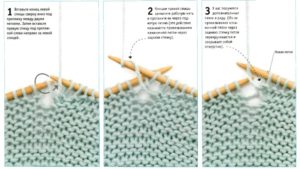
How to add stitches in garter stitch
Polish or English elastic is needed to start knitting the back, front or sleeves (photo below):

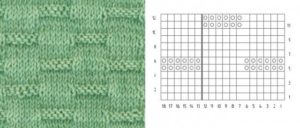
Simple scheme 1.

Simple scheme 2.

Scheme 3.

Scheme 4.

Scheme 5.

Scheme 6.
When you have chosen a pattern for a sweater, you need to knit a sample of the pattern or ornament to see how the pattern will look on the yarn. After this, the required number of loops for the back, front and sleeves is calculated. Good luck!


 0
0






I learned to knit from a suit.